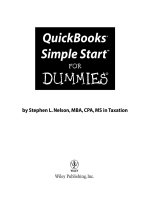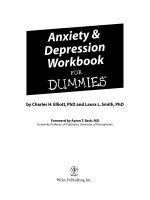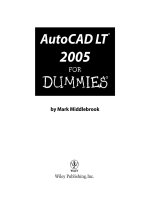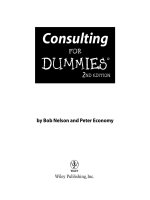quickbooks 2009 all-in-one for dummies (isbn - 0470396520)
Bạn đang xem bản rút gọn của tài liệu. Xem và tải ngay bản đầy đủ của tài liệu tại đây (19.79 MB, 628 trang )
Stephen L. Nelson,
MBA, CPA
8
IN
1
BOOKS
BOOKS
• An Accounting Primer
• Getting Ready to Use QuickBooks
• Bookkeeping Chores
• Accounting Chores
• Financial Management
• Business Plans
• Care and Maintenance
• Additional Business Resources
QuickBooks
®
2009
ALL-IN-ONE
Making Everything Easier!
™
Open the book and find:
• How to read a financial statement
• Steps for tracking accounts
receivable and payable
• Tips for managing cash and bank
accounts
• How to set up lists of customers,
vendors, and payroll items
• How to produce common financial
statements and reports
• What you can learn from ratio
analysis
• How to create and use a business
plan workbook
• Ways to simplify tax preparation
Stephen L. Nelson, MBA, CPA provides accounting, business advisory, tax
planning, and tax preparation services to small businesses. He belongs to
the American Institute of CPAs and holds an MBA in Finance and a Masters
in Taxation. His 100-plus books have sold more than four million copies.
$34.99 US / $37.99 CN / £22.99 UK
ISBN 978-0-470-39652-0
Computers/Financial Applications
Go to dummies.com
®
for more!
Here’s the book that helps you
keep your business books
with QuickBooks
QuickBooks makes it easier to handle all those financial
chores you have to do for your small business, and this
handy reference makes it easier to use QuickBooks! You’ll
find minibooks on setting up QuickBooks for your business
needs, using it for accounting, bookkeeping, and business
planning, keeping your data safe, and much more.
• Accounting 101 — Book I covers the basics of accounting if you
don’t know a debit from a credit
• Ready, set, go — learn to set up the program, load files, and
customize QuickBooks in Book II
• All about bookkeeping — in Book III you’ll see how to invoice
customers, pay vendors, track inventory, and more
• Channel your inner accountant — take on activity-based costing,
preparing a budget, and job costing in Book IV
• Explore financial strategies — Book V digs into advanced
strategies like ratio analysis, EVA, and capital budgeting
• Plan to succeed — find out in Book VI how to write the business
plan that can help you find your niche
• Keep up with upkeep — Book VII shows you how to do things that
will keep you working productively in QuickBooks
• Extra help — Book VIII covers additional resources, an Excel
primer, accounting terms, and more
An Accounting Primer
Getting Ready to Use
QuickBooks
Bookkeeping Chores
Accounting Chores
Financial
Management
Business Plans
Care and
Maintenance
Additional Business
Resources
QuickBooks
®
2009
ALL-IN-ONE
Nelson
Spine: 1.248”
QuickBooks
®
2009
ALL-IN-ONE
FOR
DUMmIES
‰
01_396520-ffirs.indd i01_396520-ffirs.indd i 12/4/08 11:11:14 PM12/4/08 11:11:14 PM
01_396520-ffirs.indd ii01_396520-ffirs.indd ii 12/4/08 11:11:15 PM12/4/08 11:11:15 PM
by Stephen L. Nelson, MBA, CPA
QuickBooks
®
2009
ALL-IN-ONE
FOR
DUMmIES
‰
01_396520-ffirs.indd iii01_396520-ffirs.indd iii 12/4/08 11:11:15 PM12/4/08 11:11:15 PM
QuickBooks
®
2009 All-in-One For Dummies
®
Published by
Wiley Publishing, Inc.
111 River Street
Hoboken, NJ 07030-5774
www.wiley.com
Copyright © 2009 by Wiley Publishing, Inc., Indianapolis, Indiana
Published by Wiley Publishing, Inc., Indianapolis, Indiana
Published simultaneously in Canada
No part of this publication may be reproduced, stored in a retrieval system or transmitted in any form or
by any means, electronic, mechanical, photocopying, recording, scanning or otherwise, except as permit-
ted under Sections 107 or 108 of the 1976 United States Copyright Act, without either the prior written
permission of the Publisher, or authorization through payment of the appropriate per-copy fee to the
Copyright Clearance Center, 222 Rosewood Drive, Danvers, MA 01923, (978) 750-8400, fax (978) 646-8600.
Requests to the Publisher for permission should be addressed to the Legal Department, Wiley Publishing,
Inc., 10475 Crosspoint Blvd., Indianapolis, IN 46256, (317) 572-3447, fax (317) 572-4355, or online at
/>Trademarks: Wiley, the Wiley Publishing logo, For Dummies, the Dummies Man logo, A Reference for the
Rest of Us!, The Dummies Way, Dummies Daily, The Fun and Easy Way, Dummies.com, Making Everything
Easier,
and related trade dress are trademarks or registered trademarks of John Wiley & Sons, Inc. and/
or its af liates in the United States and other countries, and may not be used without written permission.
QuickBooks is a registered trademark of Intuit, Inc. All other trademarks are the property of their respec-
tive owners. Wiley Publishing, Inc., is not associated with any product or vendor mentioned in this book.
LIMIT OF LIABILITY/DISCLAIMER OF WARRANTY: THE PUBLISHER AND THE AUTHOR MAKE NO
REPRESENTATIONS OR WARRANTIES WITH RESPECT TO THE ACCURACY OR COMPLETENESS OF
THE CONTENTS OF THIS WORK AND SPECIFICALLY DISCLAIM ALL WARRANTIES, INCLUDING WITH-
OUT LIMITATION WARRANTIES OF FITNESS FOR A PARTICULAR PURPOSE. NO WARRANTY MAY BE
CREATED OR EXTENDED BY SALES OR PROMOTIONAL MATERIALS. THE ADVICE AND STRATEGIES
CONTAINED HEREIN MAY NOT BE SUITABLE FOR EVERY SITUATION. THIS WORK IS SOLD WITH THE
UNDERSTANDING THAT THE PUBLISHER IS NOT ENGAGED IN RENDERING LEGAL, ACCOUNTING, OR
OTHER PROFESSIONAL SERVICES. IF PROFESSIONAL ASSISTANCE IS REQUIRED, THE SERVICES OF
A COMPETENT PROFESSIONAL PERSON SHOULD BE SOUGHT. NEITHER THE PUBLISHER NOR THE
AUTHOR SHALL BE LIABLE FOR DAMAGES ARISING HEREFROM. THE FACT THAT AN ORGANIZA-
TION OR WEBSITE IS REFERRED TO IN THIS WORK AS A CITATION AND/OR A POTENTIAL SOURCE
OF FURTHER INFORMATION DOES NOT MEAN THAT THE AUTHOR OR THE PUBLISHER ENDORSES
THE INFORMATION THE ORGANIZATION OR WEBSITE MAY PROVIDE OR RECOMMENDATIONS IT
MAY MAKE. FURTHER, READERS SHOULD BE AWARE THAT INTERNET WEBSITES LISTED IN THIS
WORK MAY HAVE CHANGED OR DISAPPEARED BETWEEN WHEN THIS WORK WAS WRITTEN AND
WHEN IT IS READ.
For general information on our other products and services, please contact our Customer Care
Department within the U.S. at 800-762-2974, outside the U.S. at 317-572-3993, or fax 317-572-4002.
For technical support, please visit www.wiley.com/techsupport.
Wiley also publishes its books in a variety of electronic formats. Some content that appears in print may
not be available in electronic books.
Library of Congress Control Number: 2008942305
ISBN: 978-0-470-39652-0
Manufactured in the United States of America
10 9 8 7 6 5 4 3 2 1
01_396520-ffirs.indd iv01_396520-ffirs.indd iv 12/4/08 11:11:15 PM12/4/08 11:11:15 PM
About the Author
Stephen L. Nelson is a CPA in Redmond, Washington. He provides account-
ing, business advisory, and tax planning and preparation services to small
businesses such as manufacturers, retailers, professional service rms, and
startup technology companies. He also teaches CPAs how to help their cli-
ents use QuickBooks more effectively and is an Adjunct Professor of Tax at
Golden Gate University, where he teaches S corporation and LLC tax law.
Curiously enough, Nelson is also the most proli c computer book writer of
all time, according to a recent feature in The Wall Street Journal. He’s also the
bestselling author of books about how to use computers to manage one’s
personal and business nances. In fact, Nelson’s 100-plus books have sold
more than 4,000,000 copies in English and have been translated into more
than a dozen other languages.
Steve holds a BS in accounting, an MBA in nance, and a Master of Science
in Taxation. He’s been a CPA for more than 25 years. He used to work as a
senior consultant with Arthur Andersen & Co. (Yes, that Arthur Andersen —
but, hey, it was a long time ago.) He also has been the controller and treas-
urer of a 50-person manufacturing rm and has run his own manufacturing
rm. Steve is also the bestselling author of Quicken 2009 For Dummies and
QuickBooks 2009 For Dummies (from Wiley).
01_396520-ffirs.indd v01_396520-ffirs.indd v 12/4/08 11:11:15 PM12/4/08 11:11:15 PM
01_396520-ffirs.indd vi01_396520-ffirs.indd vi 12/4/08 11:11:15 PM12/4/08 11:11:15 PM
Dedication
To the entrepreneurs and small-business people of the world. You folks
create most of the new jobs.
01_396520-ffirs.indd vii01_396520-ffirs.indd vii 12/4/08 11:11:15 PM12/4/08 11:11:15 PM
01_396520-ffirs.indd viii01_396520-ffirs.indd viii 12/4/08 11:11:15 PM12/4/08 11:11:15 PM
Author’s Acknowledgments
Okay, I’m not going to make this an Academy Awards–style speech, but let
me thank just a few people. First, I want to thank my business school and tax
professors at Central Washington University, the University of Washington,
and Golden Gate University. Next, thanks to the business clients who’ve given
me the honor of working with them and teaching me about their businesses
and industries. Finally, I want to thank all my friends and colleagues at Wiley
Publishing, Inc., who gave me the distinct honor of writing not only this book
but also Quicken For Dummies (14 editions) and QuickBooks For Dummies
(9 editions). I also want to say a speci c thanks to Bob Woerner, my acqui-
sitions editor; Chris Morris, my project editor; Virginia Sanders, my copy
editor; and David Ringstrom, who performed the technical edit.
01_396520-ffirs.indd ix01_396520-ffirs.indd ix 12/4/08 11:11:15 PM12/4/08 11:11:15 PM
Publisher’s Acknowledgments
We’re proud of this book; please send us your comments through our online registration form
located at www.dummies.com/register/.
Some of the people who helped bring this book to market include the following:
Acquisitions, Editorial
Senior Project Editor: Christopher Morris
(Previous Edition: Pat O’Brien)
Senior Acquisitions Editor: Bob Woerner
Copy Editor: Virginia Sanders
Technical Editor: David Ringstrom
Editorial Manager: Kevin Kirschner
Editorial Assistant: Amanda Foxworth
Sr. Editorial Assistant: Cherie Case
Cartoons: Rich Tennant (
www.the5thwave.com)
Composition Services
Project Coordinator: Lynsey Stanford
Layout and Graphics: Stacie Brooks,
Reuben W. Davis, Sarah Philippart,
Christine Williams
Proofreaders: Broccoli Information Mgt.,
David Faust
Indexer:
Claudia Bourbeau
Publishing and Editorial for Technology Dummies
Richard Swadley, Vice President and Executive Group Publisher
Andy Cummings, Vice President and Publisher
Mary Bednarek, Executive Acquisitions Director
Mary C. Corder, Editorial Director
Publishing for Consumer Dummies
Diane Graves Steele, Vice President and Publisher
Composition Services
Gerry Fahey, Vice President of Production Services
Debbie Stailey, Director of Composition Services
01_396520-ffirs.indd x01_396520-ffirs.indd x 12/4/08 11:11:15 PM12/4/08 11:11:15 PM
Contents at a Glance
Introduction 1
Book I: An Accounting Primer 7
Chapter 1: Principles of Accounting 9
Chapter 2: Double-Entry Bookkeeping 29
Chapter 3: Special Accounting Problems 47
Book II: Getting Ready to Use QuickBooks 69
Chapter 1: Setting Up QuickBooks 71
Chapter 2: Loading the Master File Lists 89
Chapter 3: Fine-Tuning QuickBooks 109
Book III: Bookkeeping Chores 135
Chapter 1: Invoicing Customers 137
Chapter 2: Paying Vendors 169
Chapter 3: Tracking Inventory and Items 187
Chapter 4: Managing Cash and Bank Accounts 215
Chapter 5: Paying Employees 245
Book IV: Accounting Chores 255
Chapter 1: For Accountants Only 257
Chapter 2: Preparing Financial Statements and Reports 271
Chapter 3: Preparing a Budget 291
Chapter 4: Using Activity-Based Costing 303
Chapter 5: Setting Up Project and Job Costing Systems 319
Book V: Financial Management 331
Chapter 1: Ratio Analysis 333
Chapter 2: Economic Value Added Analysis 351
Chapter 3: Capital Budgeting in a Nutshell 363
02_396520-ftoc.indd xi02_396520-ftoc.indd xi 12/4/08 11:11:26 PM12/4/08 11:11:26 PM
Book VI: Business Plans 379
Chapter 1: Pro t-Volume-Cost Analysis 381
Chapter 2: Creating a Business Plan Forecast 401
Chapter 3: Writing a Business Plan 437
Book VII: Care and Maintenance 451
Chapter 1: Administering QuickBooks 453
Chapter 2: Protecting Your Data 469
Chapter 3: Troubleshooting 483
Book VIII: Appendixes 489
Appendix A: A Crash Course in Excel 491
Appendix B: Government Web Resources for Businesses 509
Appendix C: Glossary of Accounting and Financial Terms 529
Index 563
02_396520-ftoc.indd xii02_396520-ftoc.indd xii 12/4/08 11:11:26 PM12/4/08 11:11:26 PM
Table of Contents
Introduction 1
About This Book 1
How to Use This Book 2
Foolish Assumptions 3
How This Book Is Organized 4
Book I: An Accounting Primer 4
Book II: Getting Ready to Use QuickBooks 4
Book III: Bookkeeping Chores 4
Book IV: Accounting Chores 4
Book V: Financial Management 4
Book VI: Business Plans 4
Book VII: Care and Maintenance 5
Book VIII: Appendixes 5
Stuff at My Web Site 5
Conventions Used in This Book 5
Special Icons 6
Book I: An Accounting Primer 7
Chapter 1: Principles of Accounting. . . . . . . . . . . . . . . . . . . . . . . . . . . . . .9
The Purpose of Accounting 9
The big picture 10
Managers, investors, and entrepreneurs 10
External creditors 10
Government agencies 11
Business form generation 11
Reviewing the Common Financial Statements 12
The income statement 12
Balance sheet 15
Statement of cash ows 18
Other accounting statements 21
Putting it all together 22
02_396520-ftoc.indd xiii02_396520-ftoc.indd xiii 12/4/08 11:11:26 PM12/4/08 11:11:26 PM
QuickBooks 2009 All-in-One For Dummies
xiv
The Philosophy of Accounting 24
Revenue principle 24
Expense principle 24
Matching principle 25
Cost principle 25
Objectivity principle 25
Continuity assumption 26
Unit-of-measure assumption 26
Separate entity assumption 26
A Few Words about Tax Accounting 27
Chapter 2: Double-Entry Bookkeeping. . . . . . . . . . . . . . . . . . . . . . . . . . .29
The Fiddle-Faddle Method of Accounting 30
How Double-Entry Bookkeeping Works 32
The accounting model 33
Talking mechanics 35
Almost a Real-Life Example 38
Rent expense 39
Wages expense 39
Supplies expense 39
Recording sales revenue 40
Recording cost of goods sold 40
Recording the payoff of accounts payable 41
Recording the payoff of a loan 41
Calculating account balance 41
Using T-account analysis results 44
A Few Words about How QuickBooks Works 45
Chapter 3: Special Accounting Problems . . . . . . . . . . . . . . . . . . . . . . . .47
Working with Accounts Receivable 47
Recording a sale 48
Recording a payment 48
Estimating bad debt expense 49
Removing uncollectible accounts receivable 50
Recording Accounts Payable Transactions 51
Recording a bill 51
Paying a bill 51
Some other accounts payable pointers 52
Inventory Accounting 53
Dealing with obsolete inventory 53
Dealing with inventory shrinkage 56
Accounting for Fixed Assets 57
Purchasing a xed asset 57
Dealing with depreciation 57
Disposing of a xed asset 58
02_396520-ftoc.indd xiv02_396520-ftoc.indd xiv 12/4/08 11:11:26 PM12/4/08 11:11:26 PM
Table of Contents
xv
Recognizing Liabilities 60
Borrowing money 61
Making a loan payment 61
Accruing liabilities 62
Closing Out Revenue and Expense Accounts 65
The traditional close 66
The QuickBooks close 66
One More Thing . . . 67
Book II: Getting Ready to Use QuickBooks 69
Chapter 1: Setting Up QuickBooks . . . . . . . . . . . . . . . . . . . . . . . . . . . . . .71
Planning Your New QuickBooks System 71
What accounting does 71
What accounting systems do 72
What QuickBooks does 72
And now for the bad news 72
Installing QuickBooks 73
Dealing with the Pre-Interview Jitters 74
Preparing for the interview 75
What happens during the interview 76
Running the EasyStep Interview 76
The big Welcome 76
Supplying company information 77
Customizing QuickBooks 78
Setting your start date 79
Adding bank accounts 80
Reviewing the suggested chart of accounts 81
Looking at the QuickBooks Learning Center window 82
Identifying the Starting Trial Balance 83
A simple example to start 83
A real-life example to nish 85
Supplying the missing account balances . . . 86
Chapter 2: Loading the Master File Lists . . . . . . . . . . . . . . . . . . . . . . . . .89
Setting Up the Chart of Accounts List 90
Setting Up the Item List 94
Working with the Price Level List 94
Using Sales Tax Codes 95
Setting Up a Payroll Item List 95
Setting Up Classes 97
Setting Up a Customer List 99
Setting Up the Vendor List 102
Setting Up a Fixed Assets List 105
02_396520-ftoc.indd xv02_396520-ftoc.indd xv 12/4/08 11:11:26 PM12/4/08 11:11:26 PM
QuickBooks 2009 All-in-One For Dummies
xvi
Setting Up Your Employees 106
Setting Up an Other Names List 107
Setting Up the Pro le Lists 107
Chapter 3: Fine-Tuning QuickBooks. . . . . . . . . . . . . . . . . . . . . . . . . . . .109
Accessing the Preferences Settings 110
Setting the Accounting Preferences 111
Using account numbers 112
General accounting options 112
Setting the Bill Preferences 113
Setting the Checking Preferences 114
Changing the Desktop View 115
Setting Finance Charge Calculation Rules 117
Setting General Preferences 118
Controlling Integrated Applications 119
Controlling Inventory 120
Controlling How Jobs and Estimates Work 121
Dealing with Multiple Currencies 121
Controlling How Payroll Works 122
Telling QuickBooks How Reminders Should Work 123
Specifying Reports & Graphs Preferences 124
Setting Sales & Customers Preferences 127
Specifying How Sales Are Taxed 128
Setting the Send Forms Preferences 130
Fine-Tuning the Service Connection 130
Controlling Spell Checking 131
Controlling How 1099 Tax Reporting Works 132
Setting Time & Expenses Preferences 132
Book III: Bookkeeping Chores 135
Chapter 1: Invoicing Customers. . . . . . . . . . . . . . . . . . . . . . . . . . . . . . . .137
Choosing an Invoice Form 137
Customizing an Invoice Form 138
Choosing a template to customize 138
Easy invoice customizations 139
Reviewing the Additional Customization options 140
Working with the Layout Designer tool 144
Invoicing a Customer 147
Billing for Time 152
Using a weekly timesheet 153
Timing single activities 153
Including billable time on an invoice 155
Printing Invoices 157
02_396520-ftoc.indd xvi02_396520-ftoc.indd xvi 12/4/08 11:11:26 PM12/4/08 11:11:26 PM
Table of Contents
xvii
E-Mailing Invoices 157
Recording a Sales Receipt 158
Recording Credit Memos 160
Receiving Customer Payments 162
Assessing Finance Charges 164
Setting up nance charge rules 164
Calculating nance charges 165
Customer Odds and Ends 166
Chapter 2: Paying Vendors . . . . . . . . . . . . . . . . . . . . . . . . . . . . . . . . . . . .169
Creating a Purchase Order 169
A real purchase order 170
Purchase order tips and tricks 173
Recording the Receipt of Items 173
Simultaneously Recording the Receipt and the Bill 176
Entering a Bill 177
If you haven’t previously recorded an item receipt 177
If you have previously recorded an item receipt 179
Recording a credit memo 181
Paying Bills 181
Reviewing the Other Vendor Menu Commands 184
Vendor Center 184
Sales Tax menu commands 185
Inventory Activities 186
Print 1099s/1096 186
Item List 186
Chapter 3: Tracking Inventory and Items. . . . . . . . . . . . . . . . . . . . . . . .187
Looking at Your Item List 187
Using the Item column 188
Using the Item List window 188
Using the inventory reports 190
Adding Items to the Item List 190
Basic steps for adding an item 190
Adding a service item 191
Adding an inventory item 192
Adding a non-inventory part 194
Adding an other charge item 195
Adding a subtotal item 197
Adding a group item 198
Adding a discount item 198
Adding a payment item 200
Adding a sales tax item 200
Setting up a sales tax group 202
Adding custom elds to items 203
02_396520-ftoc.indd xvii02_396520-ftoc.indd xvii 12/4/08 11:11:26 PM12/4/08 11:11:26 PM
QuickBooks 2009 All-in-One For Dummies
xviii
Editing Items 204
Adjusting Physical Counts and Inventory Values 204
Adjusting Prices and Price Levels 207
Using the Change Item Prices command 207
Using price levels 208
Inventory in a Manufacturing Firm 210
Manufactured inventory the simple way 211
Inventory accounting in QuickBooks Premier 211
Chapter 4: Managing Cash and Bank Accounts. . . . . . . . . . . . . . . . . .215
Writing Checks 215
Recording and printing a check 215
Customizing the check form 221
Making Bank Deposits 223
Transferring Money between Bank Accounts 226
Working with the Register 227
Recording register transactions 227
Using Register window commands and buttons 230
Using Edit Menu Commands 233
Reconciling the Bank Account 238
Reviewing the Other Banking Commands 240
Order Checks & Envelopes command 241
Enter Credit Card Charges command 241
Online Banking command 242
Online Banking Center command 242
Loan Manager 243
Other Names list 244
Chapter 5: Paying Employees. . . . . . . . . . . . . . . . . . . . . . . . . . . . . . . . . .245
Setting Up Basic Payroll 245
Signing up for a payroll service 246
Setting up employees 247
Setting up year-to-date amounts 251
Checking your payroll setup data 251
Scheduling Payroll Runs 252
Paying Employees 252
Editing and Voiding Paychecks 253
Paying Payroll Liabilities 254
Book IV: Accounting Chores 255
Chapter 1: For Accountants Only. . . . . . . . . . . . . . . . . . . . . . . . . . . . . . .257
Working with QuickBooks Journal Entries 257
Recording a journal entry 258
Reversing a journal entry 259
Editing journal entries 259
02_396520-ftoc.indd xviii02_396520-ftoc.indd xviii 12/4/08 11:11:27 PM12/4/08 11:11:27 PM
Table of Contents
xix
Updating Company Information 260
Working with the Memorized Transactions 260
Reviewing the Accountant & Taxes Reports 261
A Few Words about the Decision Tools 263
Creating an Accountant’s Copy of the QuickBooks Data File 264
Creating an accountant’s copy 264
Using an accountant’s copy 266
Reusing an accountant’s copy 267
Exporting client changes 267
Importing accountant’s changes 269
Canceling accountant’s changes 270
Chapter 2: Preparing Financial Statements and Reports . . . . . . . . . .271
Some Wise Words Up Front 271
Producing a Report 272
Working with the Report Window 273
Working with Report window buttons 274
Using the Report window boxes 279
Modifying a Report 280
Using the Display tab 281
Using the Filters tab 283
Using the Header/Footer tab 284
Formatting fonts and numbers 285
Processing Multiple Reports 287
A Few Words about Document Retention 288
Chapter 3: Preparing a Budget. . . . . . . . . . . . . . . . . . . . . . . . . . . . . . . . .291
Reviewing Common Budgeting Tactics 291
Top-line budgeting 291
Zero-based budgeting 292
Benchmarking 293
Putting it all together 294
Practical Approaches to Budgeting 294
Using the Set Up Budgets Window 294
Creating a new budget 295
Working with an existing budget 297
Managing with a Budget 298
Some Wrap-Up Comments on Budgeting 300
Chapter 4: Using Activity-Based Costing. . . . . . . . . . . . . . . . . . . . . . . .303
Revealing Traditional Overhead Allocation 303
How ABC Works 306
The ABC product line income statement 306
ABC in a small rm 309
Implementing a Simple ABC System 311
How QuickBooks Supports ABC 312
Turning On Class Tracking 312
02_396520-ftoc.indd xix02_396520-ftoc.indd xix 12/4/08 11:11:27 PM12/4/08 11:11:27 PM
QuickBooks 2009 All-in-One For Dummies
xx
Using Classes for ABC 313
Setting up your classes 313
Classifying revenue amounts 314
Classifying expense amounts 315
After-the-fact classi cations 316
Producing ABC reports 317
Chapter 5: Setting Up Project and Job Costing Systems . . . . . . . . . .319
Setting Up a QuickBooks Job 319
Tracking Job or Project Costs 322
Job Cost Reporting 324
Using Job Estimates 326
Progress Billing 328
Book V: Financial Management 331
Chapter 1: Ratio Analysis . . . . . . . . . . . . . . . . . . . . . . . . . . . . . . . . . . . . .333
Some Caveats about Ratio Analysis 334
Liquidity Ratios 335
Current ratio 335
Acid test ratio 336
Leverage Ratios 336
Debt ratio 337
Debt equity ratio 337
Times interest earned ratio 338
Fixed-charges coverage ratio 339
Activity Ratios 341
Inventory turnover ratio 341
Days of inventory ratio 342
Average collection period ratio 343
Fixed asset turnover ratio 344
Total assets turnover ratio 344
Pro tability Ratios 345
Gross margin percentage 345
Operating income/sales 346
Pro t margin percentage 346
Return on assets 347
Return on equity 347
Chapter 2: Economic Value Added Analysis. . . . . . . . . . . . . . . . . . . . .351
Introducing the Logic of EVA 351
EVA in Action 352
An example of EVA 354
Another example of EVA 354
02_396520-ftoc.indd xx02_396520-ftoc.indd xx 12/4/08 11:11:27 PM12/4/08 11:11:27 PM
Table of Contents
xxi
Some Important Points about EVA 355
Using EVA When Your Business Has Debt 356
The rst example of the modi ed EVA formula 357
Another EVA with debt example 358
Two Final Pointers 360
And Now a Word to My Critics 361
Chapter 3: Capital Budgeting in a Nutshell. . . . . . . . . . . . . . . . . . . . . .363
Introducing the Theory of Capital Budgeting 363
The big thing is the return 364
One little thing is maturity 364
Another little thing is risk 365
Putting It All Together 365
Calculating the Rate of Return on Capital 366
Calculate the investment amount 366
Estimate the net cash ows 367
Calculating the return 371
Measuring Liquidity 375
Thinking about Risk 376
What Does All This Have to Do with QuickBooks? 377
Book VI: Business Plans 379
Chapter 1: Profi t-Volume-Cost Analysis. . . . . . . . . . . . . . . . . . . . . . . . .381
How Pro t-Volume-Cost Analysis Works 382
Calculating Breakeven Points 384
Using Real QuickBooks Data for Pro t-Volume-Cost Analysis 386
Sales revenue 386
Gross margin percentage 386
Fixed costs 387
The Downside of the Pro t-Volume-Cost Model 388
Using the Pro t-Volume-Cost Analysis Workbook 389
Collecting your inputs 390
Understanding the breakeven analysis 393
Understanding the pro t-volume-cost forecast 394
Looking at the pro t-volume-cost charts 396
Chapter 2: Creating a Business Plan Forecast . . . . . . . . . . . . . . . . . . .401
Reviewing Financial Statements and Ratios 401
Using the Business Plan Workbook 403
Understanding the Workbook Calculations 409
Forecasting inputs 410
Balance Sheet 410
Common Size Balance Sheet 417
02_396520-ftoc.indd xxi02_396520-ftoc.indd xxi 12/4/08 11:11:27 PM12/4/08 11:11:27 PM
QuickBooks 2009 All-in-One For Dummies
xxii
Income Statement 419
Common Size Income Statement 423
Cash Flow Statement 423
Inventory Investments 427
Financial Ratios Table 430
Customizing the Starter Workbook 434
Changing the number of periods 435
Ratio analysis on existing nancial statements 435
Calculating taxes for a current net loss before taxes 436
Combining this workbook with other workbooks 436
Chapter 3: Writing a Business Plan . . . . . . . . . . . . . . . . . . . . . . . . . . . .437
What the Term Business Plan Means 437
A Few Words about Strategic Plans 437
Cost strategies 438
Differentiated products and services strategies 438
Focus strategies 439
Look, Ma: No Strategy 439
Two comments about tactics 440
Six nal strategy pointers 441
Writing a White Paper Business Plan 441
Writing a New Venture Plan 445
Is the new venture’s product or service feasible? 445
Does the market want the product or service? 445
Can the product or service be pro tably sold? 446
Is the return on the venture adequate
for prospective investors? 446
Can existing management run the business? 447
Some nal thoughts 448
Book VII: Care and Maintenance 451
Chapter 1: Administering QuickBooks. . . . . . . . . . . . . . . . . . . . . . . . . .453
Keeping Your Data Con dential 453
Using Windows security 453
Using QuickBooks security 454
QuickBooks in a Multi-User Environment 455
Setting up additional QuickBooks users 455
Changing user rights 460
A Few Words about Closing 462
Using Audit Trails 462
Turning on Audit Trail Tracking 462
Producing an Audit Trail Report 462
Simultaneous Multi-User Access 463
Maintaining Good Accounting Controls 464
02_396520-ftoc.indd xxii02_396520-ftoc.indd xxii 12/4/08 11:11:27 PM12/4/08 11:11:27 PM
Table of Contents
xxiii
Chapter 2: Protecting Your Data . . . . . . . . . . . . . . . . . . . . . . . . . . . . . . .469
Backing Up the QuickBooks Data File 469
Backing up basics 469
What about online backup? 472
Some backup tactics 473
Restoring a QuickBooks Data File 473
Cleaning Up the QuickBooks Company Files 477
Cleanup basics 478
Some clean-up and archiving strategies 481
Chapter 3: Troubleshooting . . . . . . . . . . . . . . . . . . . . . . . . . . . . . . . . . . .483
Using the QuickBooks Help File and This Book 483
Browsing Intuit’s Product-Support Web Site 484
Checking Another Vendor’s Product-Support Web Site 485
Tapping into Intuit’s Product-Support System 487
Trying an Internet Newsgroup 488
When All Else Fails . . . 488
Book VIII: Appendixes 489
Appendix A: A Crash Course in Excel . . . . . . . . . . . . . . . . . . . . . . . . . .491
Starting Excel 491
Stopping Excel 492
Explaining Excel’s Workbooks 493
Putting Text, Numbers, and Formulas into Cells 494
Writing Formulas 494
Scrolling through Big Workbooks 495
Copying and Cutting Cell Contents 496
Copying cell contents 496
Moving cell contents 497
Moving and copying formulas 497
Formatting Cell Contents 499
Functions Are Simply Formulas 500
Saving and Opening Workbooks 503
Saving a workbook 503
Opening a workbook 504
Printing Excel Workbooks 505
One Other Thing to Know 507
Appendix B: Government Web Resources for Businesses . . . . . . . .509
Bureau of Economic Analysis 509
Information available at the BEA Web site 510
Downloading a BEA publication 510
Uncompressing a BEA publication 511
Using the BEA publication 512
02_396520-ftoc.indd xxiii02_396520-ftoc.indd xxiii 12/4/08 11:11:27 PM12/4/08 11:11:27 PM









